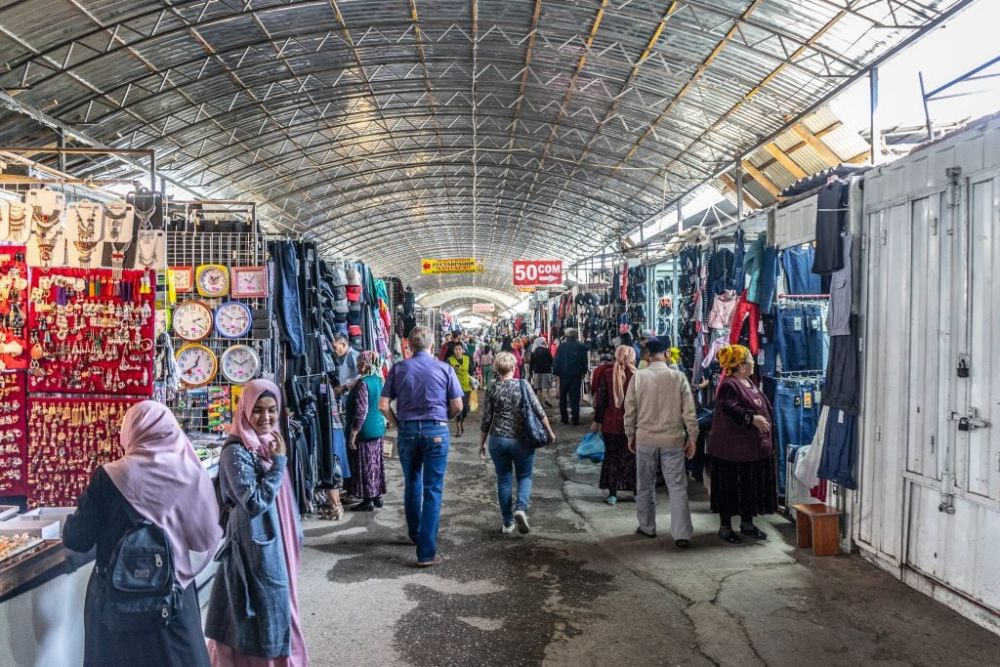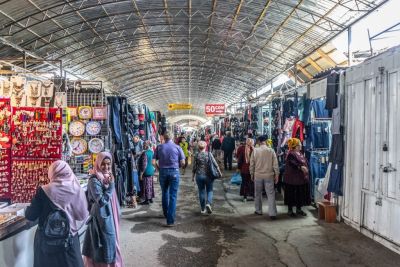

Jayma Bazaar is the crown jewel of Osh, a vibrant market that has been in operation for centuries, and is an essential part of any visit to Kyrgyzstan's second-largest city. As you enter this labyrinth of commerce, you'll be immediately immersed in a sensory overload, with colors, smells, and sounds that define Central Asian culture. Vendors sell everything from fresh produce, spices, and nuts to handcrafted textiles, clothing, and traditional hats. The bazaar is also a fantastic place to purchase Kyrgyzstan's famous felt products, including shyrdaks (felt carpets) and ala-kiyiz (embroidered felt rugs). Each product has a story, and many are made using techniques passed down through generations. Intricate patterns and motifs on the crafts reflect Kyrgyz history and nomadic lifestyle. Exploring this place is not just about shopping; it's a cultural experience that offers a glimpse into the local way of life. The duration of this self-guided tour can range from an hour to a full day, depending on personal interest and pace.
Embark on a culinary journey through Jayma Bazaar, where you can sample a wide array of traditional Kyrgyz foods. This tour will provide you with a deep dive into the flavors and culinary traditions of Osh. As you walk through the market, an expert local guide will introduce you to the best spots for fresh bread, locally fermented dairy products, and hand-pulled noodles. A highlight will undoubtedly be savoring Osh's famous plov, a rice dish cooked in a kazan (cast iron cauldron) with carrots, onions, and meat. You'll also sample samsy, baked pastries filled with meat or vegetables; kebabs; and various dumplings. Each tasting will be an opportunity to learn about the food's cultural significance and how it fits into Kyrgyz daily life. Expect the tour to last a couple of hours, and bring your appetite—there will be plenty of delicious bites to enjoy.
Capture the essence of Kyrgyz culture on a photography tour of Jayma Bazaar, where the vibrant colors and bustling energy provide endless opportunities for stunning photographs. A professional photographer or local guide can lead you to the best spots to capture the daily life, portraits of local vendors, and the intricate details of the goods sold. You will have the chance to photograph the dynamic interplay of light and shadow as the sun filters through the bazaar's canopies, casting patterns on the traditional textiles and crafts. Participants will learn how best to approach and photograph people in a respectful way, techniques for composition in a busy environment, and tips for capturing the movement and life of the market. The photography walk can be tailored to the skill level and interest of the participants, ensuring that both novices and experienced photographers will come away with improved skills and beautiful images.
For a hands-on experience at Jayma Bazaar, engage in a textile and craft workshop. This interactive activity connects you with artisans who will teach you about traditional Kyrgyz craftsmanship. Learn how to make your own shyrdak or ala-kiyiz under the guidance of skilled craftspersons who have inherited their skills through generations. As you work with natural materials like wool and dyes, you'll understand the intricate work behind these products that usually feature geometric designs and natural symbols. The workshop also provides a unique insight into the cultural significance of these textiles and their importance to the Kyrgyz people, giving you a memorable and meaningful souvenir that you've made yourself. The workshops can range from a couple of hours to a full day, depending on the complexity of the craft you choose to engage with.
Visiting Jayma Bazaar offers a unique opportunity to sit down over a cup of tea with the local traders and residents. Such an interaction provides an authentic and personal insight into the daily lives and cultures of the people of Osh. Typically, you will be invited to join at a chaikhana, or teahouse, where the tradition of drinking tea is a significant social activity. Engage in friendly conversation while enjoying a cup of traditional Kyrgyz black or green tea, often accompanied by local bread and snacks. It’s a chance to learn about their customs, hear personal stories, and perhaps even pick up a few phrases in Kyrgyz or Uzbek. These interactions can be informal or planned as part of a cultural exchange tour. A chat over tea can last for an hour or more, depending on the connection you make and the flow of conversation.
Experiencing live music and dance is an integral part of immersing oneself in Kyrgyz culture while visiting Jayma Bazaar. The melodies of traditional instruments like the komuz (a three-stringed lute) and kyl-kiyak (a two-stringed bowed instrument) can often be heard wafting through the air. Local dance troupes may perform in nearby venues or even within the bazaar, showcasing the dynamic and spirited dances of the Kyrgyz people. Performances feature colorful costumes and are often based on stories or themes from Kyrgyz folklore and history. Attendees should expect a captivating display of cultural pride and artistry, emphasizing agility, grace, and the deep connection of the Kyrgyz people to their nomadic heritage. Performances may be scheduled events or spontaneous, ranging from a short show to a full evening's entertainment.
Jayma Bazaar is not only a place for commerce but also situated around various historic sites in Osh. Taking a walking history tour of the area provides an understanding of the depth of history that surrounds the market. Not far from the bazaar, visitors can find significant sites such as the Sulaiman-Too Sacred Mountain, a UNESCO World Heritage Site with petroglyphs, museums, and panoramic views of the city. Visitors can also explore the Asaf ibn Burkhia Mausoleum and the centuries-old Rabat Abdul Khan Mosque. Each site has its own story and significance, contributing to the rich tapestry of Osh's Silk Road heritage. During the tour, guides share stories of Osh's past, including its role in regional trade, making the history of the region come alive. Such a tour can add a layer of depth and context to the experience of the bazaar itself.
The Jayma Bazaar offers a sensory expedition for those interested in discovering the varied spices and herbs used in Central Asian cuisine. Visitors can join a guided spice tour to learn about the different uses, benefits, and historical significance of spices like cumin, coriander, and sumac. The guide will introduce you to spice merchants who can explain how to use these ingredients in traditional Kyrgyz dishes. Participants may also learn about the medicinal properties of various herbs and how they are incorporated into local life. This exploration allows for a deeper appreciation of the flavors that make up Kyrgyzstan's culinary landscape and can be an inspiring experience for cooks and food enthusiasts looking to expand their palates and knowledge.
While exploring Jayma Bazaar is a highlight for many visitors, the wider city of Osh also offers a rich historical and cultural context that can be enjoyed through a guided walking tour. Traverse the cityscape and learn about landmarks like the Osh National Drama Theater, the Lenin statue, and the Osh Regional Museum. A local guide will provide tales of the city's past and present, adding depth to the diverse architecture and public spaces you will encounter. The tour can offer insights into the Soviet influence on the city's development, as well as pre-Soviet history, trade routes, and Osh's role as a melting pot of cultures. As you walk the streets, you'll gain a sense of the daily life and heartbeat of this ancient city that has been a crucial hub for travelers and traders for over a millennium.
For those inspired by the rich flavors of Central Asian cuisine, cooking classes are available, providing a hands-on experience in creating traditional Kyrgyz dishes. Held by local chefs or skilled home cooks, these classes often begin with a trip to Jayma Bazaar to select fresh ingredients. Participants then proceed to a kitchen where they're taught how to prepare dishes such as plov, manty (steamed dumplings), and beshbarmak (noodles with meat). Cooking classes offer not just a culinary skill but also the cultural significance behind the food, methods of preparation, and the communal aspects of sharing meals. It's a convivial and educational experience that culminates in the joy of eating a self-prepared meal, and it's sure to leave participants with memorable tastes and stories to bring back home.
